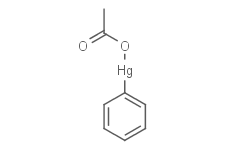
Phenylmercuric acetate
CAS No. 62-38-4
Phenylmercuric acetate( —— )
Catalog No. M19512 CAS No. 62-38-4
A phenyl mercury compound used mainly as a fungicide. Has also been used as a herbicide slimicide and bacteriocide.
Purity : >98% (HPLC)
 COA
COA
 Datasheet
Datasheet
 HNMR
HNMR
 HPLC
HPLC
 MSDS
MSDS
 Handing Instructions
Handing Instructions
| Size | Price / USD | Stock | Quantity |
| 100MG | Get Quote | Get Quote |


|
| 200MG | Get Quote | Get Quote |


|
| 500MG | Get Quote | Get Quote |


|
| 1G | Get Quote | Get Quote |


|
Biological Information
-
Product NamePhenylmercuric acetate
-
NoteResearch use only, not for human use.
-
Brief DescriptionA phenyl mercury compound used mainly as a fungicide. Has also been used as a herbicide slimicide and bacteriocide.
-
DescriptionA phenyl mercury compound used mainly as a fungicide. Has also been used as a herbicide slimicide and bacteriocide.
-
In Vitro——
-
In Vivo——
-
Synonyms——
-
PathwayGPCR/G Protein
-
TargetAntibacterial
-
RecptorOthers
-
Research Area——
-
Indication——
Chemical Information
-
CAS Number62-38-4
-
Formula Weight336.74
-
Molecular FormulaC8H8HgO2
-
Purity>98% (HPLC)
-
SolubilityDMSO:10 mM
-
SMILESCC(=O)O[Hg]C1=CC=CC=C1
-
Chemical Name——
Shipping & Storage Information
-
Storage(-20℃)
-
ShippingWith Ice Pack
-
Stability≥ 2 years
Reference
1.Xu Y et al. J Antimicrob ChemOthers. 2012 Aug;67(8):1941-4.
molnova catalog



related products
-
Phenylmercuric aceta...
A phenyl mercury compound used mainly as a fungicide. Has also been used as a herbicide slimicide and bacteriocide.
-
L-Asparagine
L-asparagine is a non-essential amino acid that is involved in the metabolic control of cell functions in nerve and brain tissue.
-
Ceforanide
Ceforanide is a second-generation cephalosporin antibiotic with bactericidal activity. Ceforanide causes inhibition of bacterial cell wall synthesis by inactivating penicillin binding proteins (PBPs) thereby interfering with the final transpeptidation step required for cross-linking of peptidoglycan units which are a component of the cell wall.



 Cart
Cart
 sales@molnova.com
sales@molnova.com


